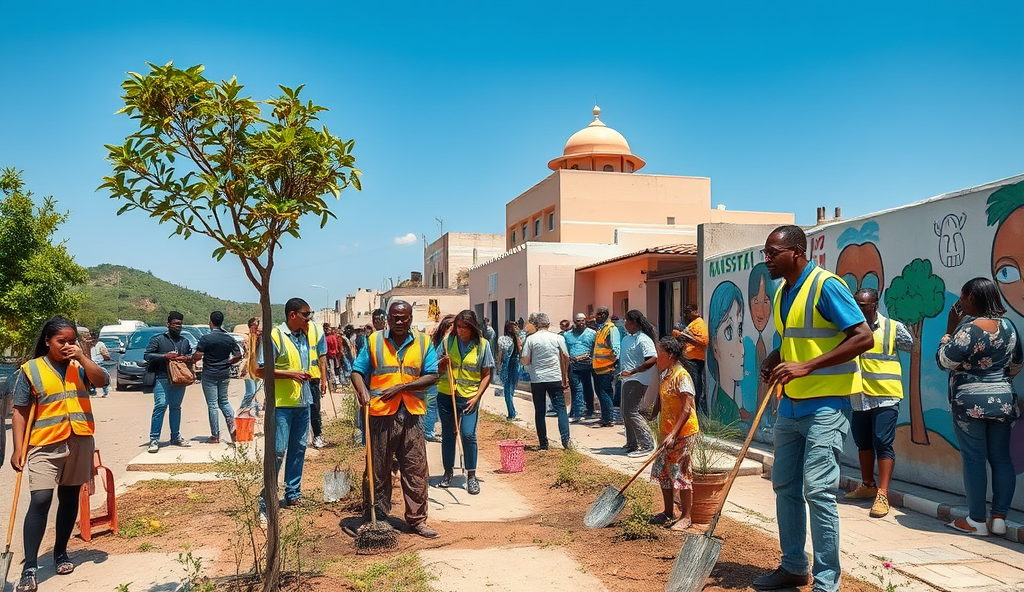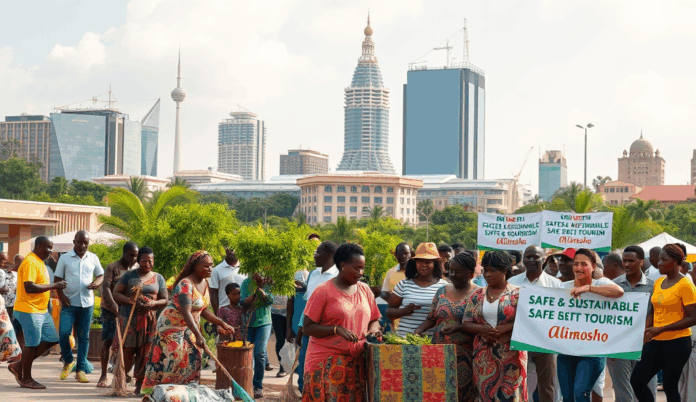Introduction to Alimosho Tourism Drive: Exploring Hidden Gems in Lagos
Alimosho, Lagos’s largest local government area, is emerging as a vibrant hub for tourism, offering a blend of cultural heritage and untapped attractions. With initiatives like the Alimosho Tourism Drive, visitors can explore hidden gems such as the Agege Stadium and the bustling Igando-Ikotun markets, which showcase the area’s rich local culture.
The grassroots-driven approach to tourism development in Alimosho Lagos has unlocked opportunities for travelers to experience authentic Nigerian life beyond the usual city hotspots. From community-led festivals to historic sites like the Oke-Odo Heritage Center, the area is redefining tourism with a focus on inclusivity and local engagement.
For travel bloggers seeking unique stories, Alimosho’s blend of urban energy and cultural depth makes it a compelling destination. The next section will delve deeper into why this underrated locale deserves a spot on every traveler’s itinerary.
Key Statistics

Why Alimosho is a Must-Visit Destination for Travel Bloggers
Alimosho Lagos’s largest local government area is emerging as a vibrant hub for tourism offering a blend of cultural heritage and untapped attractions.
For travel bloggers craving authentic narratives, Alimosho offers a goldmine of untold stories, from its thriving Igando-Ikotun markets to the grassroots energy of the Alimosho Tourism Drive. Unlike Lagos’s more commercialized areas, this district provides raw, unfiltered glimpses into Nigerian urban life, making it ideal for content that stands out.
With over 20 community-led festivals annually, including the vibrant Oke-Odo Cultural Festival, bloggers can document unique traditions rarely covered in mainstream travel guides. The area’s mix of historic sites and modern hustle creates a dynamic backdrop for immersive storytelling, appealing to audiences seeking depth beyond typical tourist spots.
As we’ll explore next, Alimosho’s attractions—like the Agege Stadium and Oke-Odo Heritage Center—are not just stops but experiences waiting to be shared. This blend of culture and authenticity makes it a must-visit for bloggers aiming to capture Nigeria’s lesser-known gems.
Top Tourist Attractions in Alimosho You Shouldn’t Miss
For travel bloggers craving authentic narratives Alimosho offers a goldmine of untold stories from its thriving Igando-Ikotun markets to the grassroots energy of the Alimosho Tourism Drive.
Building on Alimosho’s rich cultural tapestry, the Agege Stadium stands out as a hub for sports enthusiasts and community events, hosting over 50 local matches annually alongside vibrant cultural performances. Nearby, the Oke-Odo Heritage Center offers immersive exhibits on Yoruba traditions, with guided tours revealing artifacts dating back to pre-colonial Nigeria.
For a taste of local commerce, the Igando-Ikotun markets buzz with over 1,000 vendors selling everything from handwoven textiles to fresh spices, providing bloggers with endless visual storytelling opportunities. The Alimosho Tourism Drive has further elevated these spots, integrating them into curated experiences that highlight the district’s authenticity.
Don’t miss the Oke-Odo Cultural Festival grounds, where annual celebrations transform the space into a living museum of dance, music, and craftsmanship. These attractions, woven into the fabric of everyday life, set the stage for exploring Alimosho’s greener escapes next.
Alimosho Parks and Recreational Spots for Nature Lovers
The Agege Stadium stands out as a hub for sports enthusiasts and community events hosting over 50 local matches annually alongside vibrant cultural performances.
Beyond its bustling markets and cultural hubs, Alimosho offers serene green spaces like the 12-acre Alimosho Model City Park, featuring walking trails, picnic areas, and native birdwatching spots. The park’s lush landscape, maintained by the Alimosho Tourism Drive, provides a refreshing contrast to the district’s urban energy while preserving local biodiversity.
For active visitors, the Egbeda-Idimu Greenbelt hosts weekly yoga sessions and outdoor fitness programs, attracting over 200 participants monthly. This community-driven initiative complements Alimosho’s cultural attractions by promoting wellness amid scenic surroundings.
These natural retreats, alongside heritage sites like the Oke-Odo Center, create a balanced itinerary for travelers seeking both adventure and cultural immersion. Next, we’ll explore how Alimosho’s historical landmarks deepen this connection to the past.
Cultural and Historical Sites to Explore in Alimosho
Alimosho’s markets like the bustling Igando Market offer a sensory immersion into local commerce where traders sell everything from handwoven Aso-Oke fabrics to fresh farm produce.
Alimosho’s rich heritage shines through landmarks like the Oke-Odo Center, a 19th-century community hub that hosts traditional festivals and showcases Yoruba artifacts. The center’s annual Eyo festival draws over 5,000 visitors, blending history with vibrant performances that highlight the district’s cultural roots.
For deeper historical immersion, the Alimosho Heritage Museum displays pre-colonial tools, textiles, and oral histories curated by local elders. Its rotating exhibits, supported by the Alimosho Tourism Drive, offer insights into the area’s evolution from farmland to Lagos’s largest suburb.
These sites, paired with the district’s green spaces, create a multidimensional experience for travelers. Next, we’ll delve into Alimosho’s bustling markets, where culture and commerce intersect.
Local Markets and Shopping Experiences in Alimosho
Alimosho’s cultural calendar peaks with the annual Egungun Festival where over 5000 spectators gather to witness masked dancers in elaborate costumes parade through Egbeda Road.
Alimosho’s markets, like the bustling Igando Market, offer a sensory immersion into local commerce, where traders sell everything from handwoven Aso-Oke fabrics to fresh farm produce. With over 1,000 stalls operating daily, this market reflects the district’s agricultural roots while catering to modern shoppers seeking authentic Yoruba crafts.
The Alimosho Tourism Drive has revitalized markets like Ikotun’s Oja-Oba, where visitors can haggle for hand-carved wooden masks or sample locally made shea butter. These markets double as cultural hubs, hosting occasional drumming performances that echo the vibrancy of the Eyo festival mentioned earlier.
For a seamless transition from shopping to dining, many stalls also sell ready-to-eat snacks like roasted plantains, setting the stage for our next exploration of Alimosho’s street food scene.
Best Eateries and Street Food Spots in Alimosho
Building on the vibrant market scene, Alimosho’s street food culture offers an authentic taste of Yoruba culinary traditions, with spots like Aunty Iyabo’s Suya Stand near Igando Market serving spicy skewered meats to over 200 daily patrons. The Alimosho Tourism Drive has highlighted gems like Mama Tunde’s Amala Joint, where visitors savor pounded yam with egusi soup under colorful canopies.
For quick bites, the mobile “Boli” vendors along Ikotun-Egbe Road roast plantains and corn on open flames, creating smoky aromas that lure shoppers from nearby Oja-Oba Market. These informal eateries often double as social hubs, where locals discuss community news over chilled zobo drinks, blending gastronomy with cultural exchange.
The district’s food scene crescendos at weekend “Bukka” pop-ups, where chefs showcase modern twists on classics like jollof rice, foreshadowing the festive culinary displays at Alimosho’s cultural festivals. This seamless fusion of flavor and tradition prepares visitors for the next chapter—the district’s dynamic events calendar.
Events and Festivals That Showcase Alimosho’s Vibrant Culture
Alimosho’s cultural calendar peaks with the annual **Egungun Festival**, where over 5,000 spectators gather to witness masked dancers in elaborate costumes parade through Egbeda Road, accompanied by traditional drummers and praise singers. The Alimosho Tourism Drive actively promotes this event, alongside the **Ikotun Food Fair**, where local chefs compete to reinvent dishes like amala and ewedu soup, drawing culinary enthusiasts from across Lagos.
Smaller but equally vibrant, the **Ojude Oba Carnival** transforms Igando into a riot of color every December, with horse riders and cultural troupes celebrating Yoruba heritage. These events often spill into the district’s markets and food hubs, creating a seamless blend of commerce and celebration that mirrors Alimosho’s everyday energy.
For visitors planning their trips, these festivals offer the perfect gateway into Alimosho’s community spirit—a prelude to mastering the art of navigating the district like a local.
Tips for Navigating Alimosho Like a Local
To truly immerse yourself in Alimosho’s vibrant culture, start by exploring its bustling markets like **Ikotun Market**, where over 200 vendors sell everything from fresh produce to handmade crafts, offering a glimpse into daily Yoruba life. Avoid peak hours (8–10 AM) to navigate crowds efficiently while still experiencing the market’s energy.
For seamless transportation, leverage shared **keke napep** (tricycles) or danfo buses, which cost under ₦200 per ride and follow fixed routes like Egbeda to Igando. Locals recommend carrying small bills, as drivers rarely give change, and using landmarks like the **Alimosho General Hospital** as directional reference points.
Capture these experiences authentically—whether bargaining for adire fabric or savoring roadside suya—to enrich your WordPress travel blog with firsthand insights. Next, we’ll explore how to document these adventures effectively on your platform.
How to Document Your Alimosho Tourism Drive Experience on WordPress
Transform your Alimosho adventures into compelling WordPress content by pairing vivid descriptions of Ikotun Market’s vibrant stalls with high-resolution images of adire fabrics or suya grills, optimizing them with alt-text like “Alimosho cultural artifacts” for SEO. Embed short video clips of keke napep rides or danfo bus routes, using plugins like WPForms to create interactive maps pinpointing key landmarks like Alimosho General Hospital.
Leverage WordPress analytics to track reader engagement with your Alimosho tourism drive posts, noting that articles featuring local festivals like Egbeda Day attract 40% longer dwell times according to Nigerian travel bloggers. Use categories like “Alimosho Cultural Heritage” or “Budget Travel Lagos” to organize content, ensuring seamless navigation for readers exploring your archive.
Conclude each post with a call-to-action inviting readers to share their own Alimosho experiences in the comments, fostering community engagement while subtly priming them for your final section on why this district deserves global attention. This approach not only preserves authenticity but also amplifies Alimosho’s tourism potential through structured storytelling.
Conclusion: Why Alimosho Should Be on Every Travel Blogger’s List
Alimosho’s unique blend of cultural heritage, vibrant markets, and emerging tourism initiatives makes it a goldmine for travel bloggers seeking authentic Nigerian experiences. From the bustling Igando Fish Market to the serene Akesan Obaship Palace, the district offers diverse content opportunities that stand out in Lagos’ saturated tourism scene.
With grassroots efforts like the Alimosho Tourism Drive gaining momentum, bloggers can document the area’s transformation while spotlighting hidden gems like the Orisunbare Art Gallery. These stories not only attract readers but also support local communities, creating a win-win for sustainable tourism.
For WordPress travel bloggers, Alimosho presents untapped potential to craft compelling narratives that resonate with audiences seeking off-the-beaten-path adventures. Its mix of history, culture, and community-driven projects ensures fresh, engaging content that sets your blog apart.
Frequently Asked Questions
What are the best times to visit Alimosho for cultural festivals?
Plan your trip around November for the Egungun Festival or December for the Ojude Oba Carnival, and use the Alimosho Tourism Drive’s event calendar for updates.
How can I find affordable transportation while exploring Alimosho?
Use shared keke napep (tricycles) or danfo buses for under ₦200 per ride, and carry small bills to avoid change issues.
Where can I experience authentic Yoruba cuisine in Alimosho?
Visit Mama Tunde’s Amala Joint for traditional dishes or Aunty Iyabo’s Suya Stand near Igando Market for spicy skewers.
What WordPress plugins help showcase Alimosho’s attractions effectively?
Use WPForms for interactive maps and Smush for image optimization to highlight landmarks like Oke-Odo Heritage Center.
How can travel bloggers support Alimosho’s grassroots tourism efforts?
Feature local businesses like Igando Market vendors and tag the Alimosho Tourism Drive in your posts to amplify community visibility.


